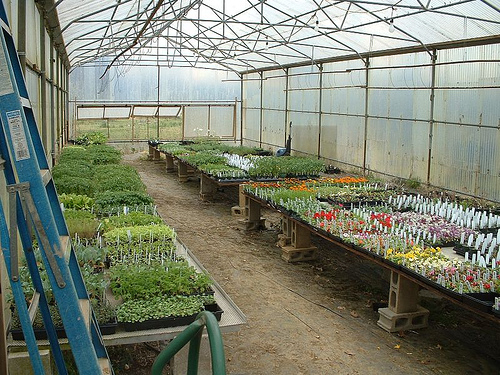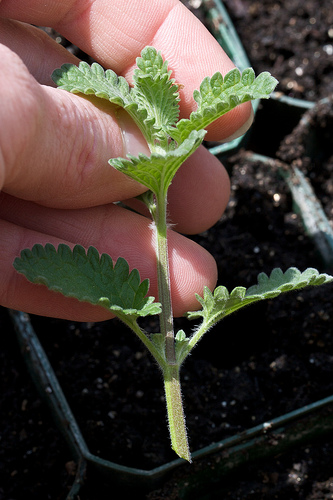Written by monthly contributor, Phoebe Hendricks of Getting Freedom
Who doesn’t love a perfectly landscaped yard, loaded with beautiful, fragrant blossoms?
While flowers add a lovely aspect to any home, attaining the look you are going for can end up breaking the bank. However, if you use your resources wisely, you can achieve your dreams for a fraction of the cost. Whether you grow your flowering plants from seeds or through plant propagation, you’ll have a stunning landscape in no time.
Planting From Seeds
While frugal, it isn’t always the easiest. You plant flowers seeds just as you would vegetable seeds. The seedlings can require a lot of watching and fertilizer for speedy growth, but it’s a frugal way to get a lot of plants quick and with little out of pocket.
Plant Division
One of the easiest ways to gain new plants is by plant division. When I purchase my flowers, either from a greenhouse or a chain retailer, I always inspect the base of the plant to see if it’s easily split-able. Basically what you’re looking for is more than one main stem/growth coming out of the soil. When you’re ready to divide them, start with moist soil, and remove the plant from the pot. Using a sharp knife, cut through the plant between the growths. Remove any damaged leaves or roots and re-pot both plants separately, using the same soil mixture originally used. Generally, flowering plants will flower the same year. The same method can also be used with plants already in your landscaping, just use a sharp hoe and dig up the cutting and replant. Thinning existing landscaping is often beneficial to the garden as whole, and the “mother” plant.
For Bulb-ous plants, many will form bulb offsets that are easily removed and able to replanted on their own. Keep in mind that some bulbs will take 2 years or more before they flower.
Stem Cutting
In any season other than winter, cut off a few inches of the stem off of a healthy plant that contains no buds or flowers. Make the cut right below the leaf joint on the stem. Pull away the lower leaves and place your cutting into a mixture of peat moss, sand and soil just below the lowest leaf. You can add more than one cutting to a 2-3″ pot. Cover with a plastic bag and keep in a warm, well lit location out of direct sunlight. Make sure to keep the soil moist, yet not wet. Waterlogging will prevent the cutting from forming roots.
It will take approximately 3-5 weeks for your cuttings to form a good root system. At this time, you will begin to see top growth. Once you see good top growth you can transfer your plant to it’s new home.
If you have a friend, neighbor, or family member that has an established flower garden, ask if you can swap plant cuttings to further maximize your plant variety and your out of pocket expenses.
This year, we will be using these methods {again} to create our flower gardens on a tight budget. During Project Major Home Addition, the contractor ruined my flower beds, and stomped all my flowers to death when they installed our new siding. So now, we’re on the lookout for new perennials to include in our landscaping.
Further reading: Tips for Edible Landscape Gardening
So, please share! What are your favorite perennials?
![]() About Phoebe
About Phoebe
Phoebe and her husband started their debt freedom journey in 2008. Along the way they’ve found that not only are they living the unconventional life, but loving it! She shares her joys of gardening, canning, cooking from scratch, and crafting on her blog, Getting Freedom. You can connect with her on Twitter and Facebook.





I love your information on gardening. I start many of my plants from seed and enjoy many varieties not found in plant form locally and at a much cheaper cost. But in all fairness and if you want to be perfectly ethical about propagating plants: Propagation of patented plants in any way, shape or form without the owner’s permission or until the patent term has expired, is strictly prohibited by federal law. Patents are for 17 or 20 years and are not renewable. Just a tidbit of information to present all the information to ‘budding’ gardeners. Thank you for your very informative newsletters and keep the deals coming!
God Bless,
Julie
@Julie, Thank you for your comment, Julie.
I must admit that I had to google “illegal propagation” to even understand what you were referring to, as I’ve NEVER heard that term before. While still a novice gardener, and propagator, I’ve done both things right along side my mom since I was a little girl {and have read many articles/books on the subjects}.
Having said all that, you do present a valid point. SOME plants indeed are patented, and in NO way would I encourage anyone to propagate them. Before propagating your chosen plant, please be make sure it doesn’t carry a current patent.
Phoebe @ GettingFreedom´s last blog post ..The Beginning- Truth Hurts
Love this idea, Phoebe!
It crazy to me that plants can be patented. I’m so glad that we use heirloom seeds so that we don’t have to run into that issue.
I’m curious though… what if you pay for the original plant? Can you legally propagate it for your own yard since you bought it in the first place?
Rachel @ Surviving The Stores´s last blog post ..Mega Swagbucks Friday